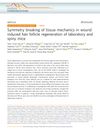Search
forLearn
4 / 4 resultslearn Osteopontin
signaling protein that, when suppressed, may grow hair by reducing inflammation and stem cell loss
learn Epidermal Growth Factor
learn Low Level Laser Therapy
laser therapy for anti-inflammatory and likely insignificant hair regrowth effects
Research
5 / 1000+ resultsresearch Adenosine and Its Receptors in the Pathogenesis and Treatment of Inflammatory Skin Diseases
Adenosine receptors could be promising targets for treating inflammatory skin diseases like psoriasis.
research 3D Bioprinting of Engineered Exosomes Secreted from M2-Polarized Macrophages Through Immunomodulatory Biomaterial Promotes In Vivo Wound Healing and Angiogenesis
3D bioprinting with special hydrogels helps heal wounds and grow new blood vessels.

research Retinoids in Scarless Skin Regeneration: From Molecular Mechanisms to Therapeutic Strategies
Retinoic acid may help heal skin without scars by reducing fibrosis and supporting skin regeneration.
research Epidermal Stem Cells in Orthopedic Regenerative Medicine
Epidermal stem cells show promise for treating orthopedic injuries and diseases.

research Symmetry Breaking of Tissue Mechanics in Wound-Induced Hair Follicle Regeneration of Laboratory and Spiny Mice
Tissue stiffness affects hair follicle regeneration, and Twist1 is a key regulator.
Community Join
5 / 98 resultscommunity Tazarotene shows strong standalone hair regrowth potential, not just a Minoxidil enhancer. Backed by VEGF, HF regeneration, and angiogenesis pathways. Here’s why.
Tazarotene shows potential as a standalone treatment for hair regrowth by stimulating new hair follicle formation and promoting angiogenesis, similar to microneedling effects. It can be used topically without minoxidil, but users should start with a low concentration to avoid irritation.
community The Fear of Oral Minoxidil is Overblown
Low-dose oral minoxidil is a safe and effective hair loss treatment with fewer side effects than previously feared. Users often prefer it over topical minoxidil for better results, though some experience side effects like increased body hair and cardiovascular issues.

community Compressed part of research of theory of androgenic/anabolitic balance. AGA h-responders analytic. Theory of physio-metabolitic method of anti AGA treatment
The treatment for androgenetic alopecia involves using finasteride and minoxidil with intense exercise and cold exposure to boost metabolism and reduce androgenic effects, potentially leading to hair regrowth. This approach may activate biological pathways for improved hair and overall health.
community Comprehensive Microneedling Guide
Microneedling for hair restoration involves daily use of a 0.3 mm device and weekly use of a 0.5 mm device. Combining microneedling with Minoxidil can enhance hair growth.

community If You Have DUPA, PLEASE READ THIS: Everyone Should Be Scalp Biopsied
Scalp biopsies are crucial for diagnosing hair loss conditions like Diffuse Unpatterned Alopecia (DUPA) and retrograde hair loss, as treatments like finasteride and dutasteride may not be effective if other conditions are present. Combining PPAR-GAMMA agonists with retinoids could improve treatments for conditions like Lichen Planopilaris.